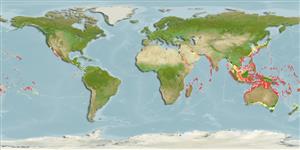分類 / Names
共通名の | 類義語 | Catalog of Fishes(部類, 種) | ITIS | CoL | WoRMS | Cloffa
Environment: milieu / climate zone / 深さの範囲 / distribution range
生態学
海 関連する礁; 深さの範囲 0 - 55 m (Ref. 90102). Tropical
Indo-West Pacific: East Africa to Micronesia, Line Islands, and Society Islands, and Taiwan to Australia (Ref. 90102); including Papua New Guinea, Line Islands and Society Islands; Taiwan to reefs of Coral Sea and New Caledonia (Ref. 54980).
サイズ / 重さ / 年齢
成熟: Lm ? range ? - ? cm
Max length : 4.0 cm TL オス/雌雄の選別がない; (Ref. 48636)
背面の脊椎 (合計) : 13 - 16; 背鰭 (合計) : 7 - 10; 肛門の骨: 1; 臀鰭: 15 - 20. Identified by the tall first dorsal fin that is white in males (Ref. 48636). Large individuals may have conspicuous dark spot on upper middle of second dorsal fin connected to a band extending down the sides as well as about 5 darker bars on body and red snout and lower head (Ref. 37816).
Body shape (shape guide): elongated.
Adults are found in various reef habitats, but often on sponges or reef outcrops (Ref. 48636). Also found in intertidal pools (Ref. 13227) and on corals and rocks (Ref. 37816). They feed on zooplankton (Ref. 48636). Eggs are hemispherical and covered with numerous sticky threads that anchor them in the algae on the nesting sites (Ref. 240). Larvae are planktonic which occur primarily in shallow, nearshore waters (Ref. 94114). The most common and most widely distributed among Enneapterygius species (Ref. 90102). Minimum depth reported from Ref. 13227.
Life cycle and mating behavior
成熟 | 繁殖 | 放精 | 卵 | 生産力 | 幼生
Fricke, R., 1994. Tripterygiid fishes of Australia, New Zealand and the southwest Pacific Ocean (Teleostei). Theses Zool. 24:1-585. (Ref. 13227)
IUCNのレッドリストの状況は (Ref. 130435: Version 2025-1)
Human uses
水産業: 興味がない
用具
特記事項
XMLをダウンロードして下さい
インターネットの情報源
Estimates based on models
Preferred temperature (参照
123201): 24.1 - 28.9, mean 27.5 °C (based on 802 cells).
Phylogenetic diversity index (参照
82804): PD
50 = 0.5000 [Uniqueness, from 0.5 = low to 2.0 = high].
Bayesian length-weight: a=0.00617 (0.00288 - 0.01322), b=3.04 (2.86 - 3.22), in cm total length, based on LWR estimates for this (Sub)family-body shape (Ref.
93245).
栄養段階 (参照
69278): 3.4 ±0.45 se; based on food items.
回復力 (参照
120179): 高い, 15か月以下の倍増期間の最小個体群 (Preliminary K or Fecundity.).
Fishing Vulnerability (Ref.
59153): Low vulnerability (10 of 100).
🛈
Nutrients (Ref.
124155): Calcium = 433 [156, 1,848] mg/100g; Iron = 2.47 [0.83, 5.79] mg/100g; Protein = 18.1 [16.2, 19.9] %; Omega3 = 0.108 [0.024, 0.510] g/100g; Selenium = 89.7 [15.6, 432.6] μg/100g; VitaminA = 35 [4, 270] μg/100g; Zinc = 5.59 [2.35, 10.78] mg/100g (wet weight);
